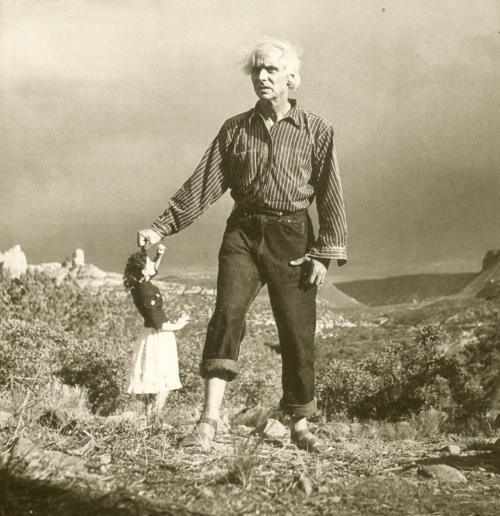
Playing with Perception:
Surrealist Artists Max Ernst and Dorothea Tanning in Sedona, Arizona
.
“Painting is not for me either decorative amusement, or the plastic invention of felt reality; it must be every time: invention, discovery, revelation.”
– Max Ernst
In the late 1930s and early 1940s there was a mass exodus of artists out of Europe, fleeing expanding Nazi power. Many came to America and settled in New York City, and went no further. They kept aloof from the local art scene and showed little interest in learning anything about their host country.
Surrealism was the dominant movement at the time, and most of the leading figures were present; they spent their time playing cruel parlor games, complaining about their exile and marking time until the war was over and they could return to true civilization on the Continent.
One notable exception was the German Dada artist Max Ernst. After the Allied victory he didn’t go home-he headed west to Arizona.
Ernst had lived a stormy bohemian life. After serving in the German military during the First World War, Ernst had helped found the Cologne Dada group. He worked with many experimental techniques, and became one of the earliest visual artists associated with the Surrealists, which had been a mainly literary movement.
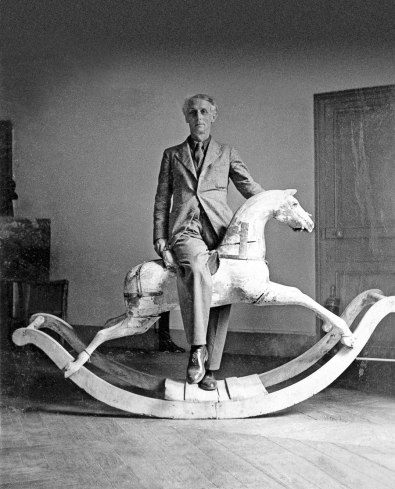
A French Nickname for “Hobby Horse”: Dada Artist Max Ernst
.
In Paris Ernst met the French poet Paul Eluard, and his Russian wife Gala. This relationship grew into a longstanding passionate ménage a trios. The wealthy Eluard helped Ernst get out of Germany by letting him use his passport. Ernst lived with them in their Paris home, covering the walls with murals. The three traveled as far away as Saigon together.

Threesome: Max, Gala and Paul
.
After this trip Ernst moved out on his own, and within a few years the Eluards marriage ended. Gala went on to become Salvador Dali’s wife and muse, and Ernst and Eluard stayed friends for the rest of theirs lives.
As World War II began, Ernst’s position was becoming less stable. As a German with ties to the radical Surrealists, Ernst was arrested by the French as a hostile alien. The well-connected Eluard managed to get him released, but after France fell, Ernst was in jeopardy again, pursued by the Gestapo.
Ernst had been one of the artists singled out by Hitler’s Degenerate Arts exhibit, and he was in danger of being arrested. He fled first to the south of France, where he was taken in by the American heiress and collector Peggy Guggenheim. A romance bloomed between them, and Guggenheim took Ernst with her back to America. As the United States entered the war, they got married-“I did not like the idea of living in sin with an enemy alien,” Peggy joked.
This marriage also did not last, and in 1946 Ernst was married again for the final time, to the brilliant American Surrealist painter Dorothea Tanning. They fell in love when Ernst came to her studio to see her painting “The Birthday,” then stayed for a game of chess.
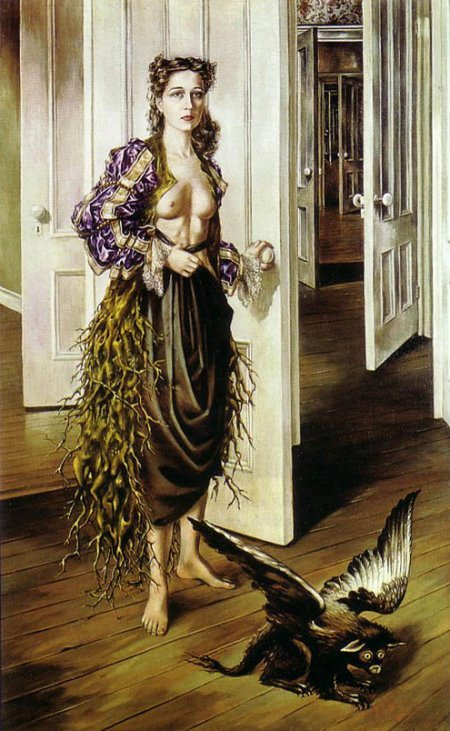
Dorothea Tanning “The Birthday”
.
While traveling across country to California, the couple drove through Arizona, and Ernst was amazed to find himself in a rugged landscape that could have come out of visionary world he painted.
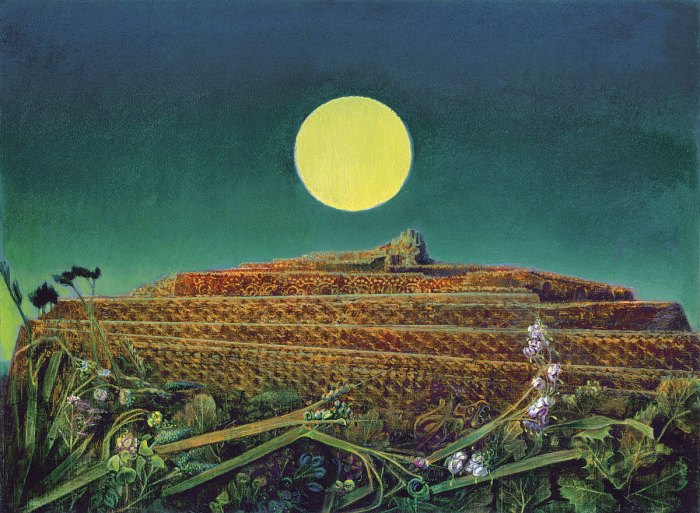
Max Ernst “The Entire City”
.
The couple ended up moving to remote Sedona, Arizona, where they remained for the next seven years. Ernst said Paris and Sedona were “the only two places in the world that I would want to live.” Sedona was incredibly isolated at the time, very different from the upscale resort community it has become. Ernst built a cabin for a home, and they continued to paint.

A Cabin in the Mountains
.
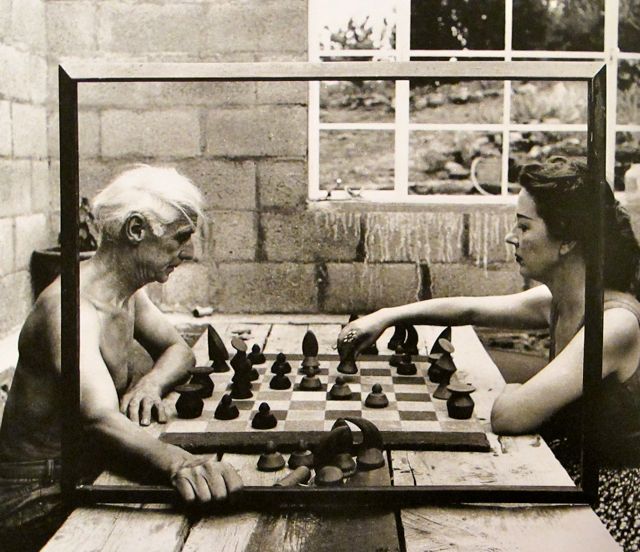
Still Playing Chess
.
Influenced by the Hopi Indian culture he encountered, his work came to show new geometric forms. He used cast concrete and found objects to make sculpture that showed Native American elements. Ernst also used his time in Sedona to write his manifesto, “Beyond Painting.”

Max Ernst and Dorothea Tanning evoke the spirit of the land
.
During these years Ernst traveled extensively, which led to complications regarding his US citizenship. In 1953 Ernst and Tanning moved to France, where they lived together until his death in 1976.
Dorothea Tanning died in New York on January 31, 2012. She was 101 years old.
.
“Art has always been the raft onto which we climb to save our sanity. I don’t see a different purpose for it now.”
-Dorothea Tanning
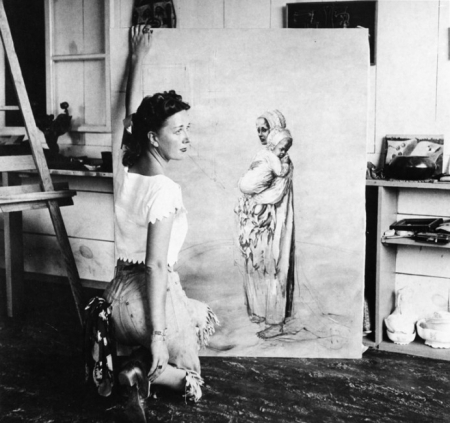
Dorothea Tanning in her Sedona studio
Wow! Thank you so much for your research and posting this. I love it!
What inspiration! 🙂
Thanks! Amazing to think of the craziness that must have gone on there.
[…] Source: ARTISTS: Max Ernst and Dorothea Tanning in Arizona | THE REMODERN REVIEW […]
“Ernst had been one of the artists singled out by Hitler’s Degenerate Arts exhibit, and he was in danger of being arrested.”
A case where that “perception” thing got very personal.
The elitists know how dangerous art can be to their control, that’s why they do so much to manipulate the art market nowadays
“much to manipulate the art market nowadays” They always have (which why they get all excited about the narrative), there is just just a whole lot more ways these days that info gets out (by new and different media) which keeps them real busy and nervous.
Good example of how the powers that be did the same in the way back days was the exile of Ovid by Augustus to an obscure port on the Black Sea. There never has been concrete evidence of why he did it, but people generally agree it was the subjects of Ovid’s writing that posed a danger to Augustus’s image and socio-political program he had going.
Nothing new under the sun-and of course the artists win in the end!
“Nothing new under the sun-and of course the artists win in the end! ” Heh.
I just noticed the similarity of the hair of the woman in your “Among the Fortunate” and Tanning’s “The Birthday” . There is a difference in I can see Tanning’s is made of a lot of little naked people hanging up there (mostly women), but there is a similarity.
Interesting! I missed that connection. It probably worked in there on a subconscious level.
Ah, just an old person with too much time on his hands indulging himself in something he sort of did for a living a long time ago. I did notice in the top photo Ernst’s pant’s legs rolled up unevenly, I wonder if he rode a bicycle?
Going back to Tanning’s “The Birthday” and the chess game, it is a well fact that a good looking woman using the unbuttoned blouse as an “opening gambit” will often lead to mate.
Good observations! I can imagine Ernst getting around primitive Sedona by bike, who knows if they even had a car. And “The Birthday” sure looks like a Dorothea Tanning self portrait, so she was very much on display.